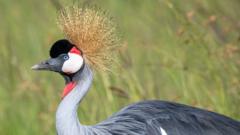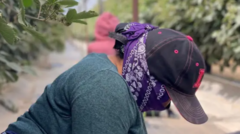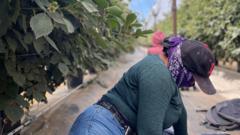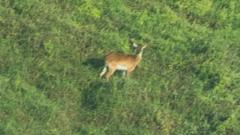The population of the iconic crested crane in Uganda has drastically declined from over 100,000 in the 1970s to around 10,000 today. Factors contributing to this vulnerability include habitat loss, poisoning by farmers, and cultural beliefs about the bird's significance. Conservationists aim to address these issues through community engagement and habitat restoration.
The Plight of Uganda's Crested Crane: From National Symbol to Endangered Species

The Plight of Uganda's Crested Crane: From National Symbol to Endangered Species
As Uganda's cherished crested crane faces extinction, farmers and conservationists clash over crop damage and protective measures.
The crested crane, a renowned symbol of Uganda with its distinctive golden crown and elegant form, is now confronted with the grim prospect of extinction. Revered across the nation, this bird graces the flag and coat of arms, embodying cultural pride. However, its population has plummeted alarmingly due to multiple factors, prompting urgent calls for conservation efforts.
Once flourishing with an estimated 100,000 individuals in the 1970s, the crested crane population has sunk to just 10,000 today—a staggering decline of over 80% in the past 25 years, according to conservationists. The IUCN has listed it as endangered since 2012, highlighting the primary threats it faces.
Farmers in western Uganda, particularly in areas where cranes are prevalent, argue that these birds are a menace to their crops. "They raid our plantations and eat our crops, impacting our food security," explains maize farmer Tom Mucunguzi. His view reflects a growing tension between agricultural needs and wildlife conservation, as many farmers actively chase away or even poison cranes to protect their crops.
Despite the legal protections in place—potential life sentences and hefty fines for killing cranes—the cultural reverence once associated with the bird has waned. Jimmy Muheebwa, a senior conservationist, recalls how historical superstitions instilled fear of harming cranes, which were seen as symbols of prosperity. Yet, the pressures of modern farming and population growth have eroded this respect.
Crested cranes inhabit wetlands and grasslands, relying on these declining ecosystems for breeding and feeding. The push for agricultural expansion into these areas has led to significant habitat loss, leaving the cranes without sufficient nesting grounds and food sources. Conservationists advocate for sustainable farming practices and the restoration of these vital habitats, yet such efforts face resistance from farmers prioritizing immediate crop yields.
The challenges extend beyond agricultural practices. Cranes find themselves vulnerable to poisons used in agriculture and face additional threats from habitat flooding, power lines, and illegal hunting. Conservationists are actively working to raise awareness among farmers about alternative crop protection methods, like scarecrows, rather than resorting to harmful measures.
Efforts are underway to rally community support for wetland conservation, as President Yoweri Museveni emphasizes the importance of restoring natural habitats. Local government bodies are starting to enforce laws against crane poisoning, with plans to prosecute repeat offenders.
Despite these initiatives, the future of Uganda's crested crane remains uncertain. While conservationists strive to stabilize their numbers through community engagement and habitat protection, a delicate balance must be struck between protecting cultural heritage and addressing the realities faced by farming communities. In the face of growing threats and shifting attitudes, the iconic crested crane’s fate hangs in the balance, calling for urgent action to ensure its survival.





















